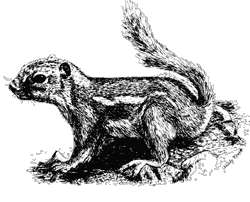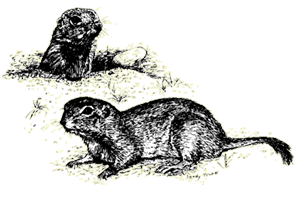Ground Squirrels
The ground squirrels belong to the rodent order — small, gnawing, mammals that many predators depend on for food.
Since we lack large trees in most of the Sonoran Desert, it’s not too surprising that our squirrels are ground dwellers. (Actually the rock squirrels and round-taileds climb quite well, and often forage in mesquites when the new leaves are budding out in the spring.) They all dig burrows to live in and retreat to for safety, but spend days on the surface when the temperature is moderate, foraging and sunning. These little creatures are well designed for digging in the dirt. All three squirrels discussed below have good claws and small ears set lower on their heads than those of tree squirrels. The round-tailed squirrel also has sleek, short fur.
All three of our squirrels are diurnal; only the Harris’ antelope squirrel is active all year. The round-tailed ground squirrel hibernates in winter in most of its range and estivates during the summer drought. The rock squirrel retreats to its burrow during cold winter periods, though scientists doubt that it actually hibernates.
Sonoran Desert species:
Harris’ antelope squirrel (Ammospermophilus harrisii)
round-tailed ground squirrel (Spermophilus tereticaudus)
rock squirrel (Spermophilus variegatus)
Order: Rodentia
Family: Sciuridae
Spanish names: ardilla (squirrel), chichimoco (Harris’ antelope squirrel),
juancito (round-tailed ground squirrel)
Distinguishing Features
The little Harris’ antelope squirrel is often mistaken for a chipmunk; chipmunks, however, are higher elevation animals, while Harris’ antelope squirrel is a creature of the rocky deserts. The Harris’ antelope squirrel has a white stripe on its side, but not on its face, and a bushy black tail that it often carries arched over the back. The underbelly is white.
The round-tailed ground squirrel is a social animal. Although it resembles a tiny prairie dog, and shares some of its habits, the two animals are not related. The round-tailed ground squirrel is light beige colored with a long, black tipped tail. It weighs only 6 or 7 ounces (170-200 g).
The rock squirrel looks like a typical tree squirrel, but is a ground dweller. It is the largest of the ground squirrels, weighing up to 1¼ pounds (0.7 kg). The rock squirrel has speckled greyish-brown fur and a long bushy tail.
Habitat

Rock squirrel
Harris’ antelope squirrels prefer the rockier habitats of the desert, though their ranges often overlap those of the round-tailed ground squirrels. Round-tailed ground squirrels live mostly on lower alluvial fans or open, flat areas of valleys. They need deeper soils where they can dig their 3 foot deep burrows. Rock Squrrels are found in many habitats throughout the region, even at high elevations in the mountains, but they are absent from the driest areas of southwestern Arizona. They are most commonly in rocky outcrops, boulder piles, or canyon walls, but they are very adaptable and make use of suburban lots, tree roots, and many other places.
Feeding
Diet:
The Harris’ antelope squirrel feeds less on green vegetation and more on fruits of cholla, prickly pear and barrel cacti, seeds, mesquite beans, insects, and occasionally, mice. The round-tailed ground squirrel depends on succulent green vegetation, such as new spring wildflowers, cactus flowers and fruit, mesquite leaves, grasses, and ocotillo flowers, but it eats seeds as well. It also will take advantage of carrion, including roadkill of its own species. The rock squirrel is an omnivore, feeding on seeds, mesquite beans and buds, insects, eggs, birds, carrion, and a variety of fruits, including the fruit of barrel cactus and prickly pear.
Behavior:
Harris’ antelope squirrels run around the desert sniffing out seeds in the ground and digging them up. Many shallow divots in the dirt are an indicator of their activity. These ground squirrels also climb up barrel cacti to get the fruit, despite the spines. Round-taileds usually don’t have to venture far from their burrows, finding enough grass seed, cacti, and vegetation nearby to satisfy their needs. They intersperse bouts of feeding with periods of sunning or relaxing in the shade of bushes.
Rock squirrels forage for food on the ground of their home areas, but can also climb trees very well. They often climb into mesquites, willows, and ocotillos when they are first leafing out, to feed on the tender new growth. They also climb flower stalks of agaves to feed on the tender tips. In addition they hunt and kill small birds and rodents.
Life History

Harris’ Antelope
The Harris’ antelope squirrel is active year-round. Evidence of Harris’ antelope squirrels in an area usually includes several 2 inch (5 cm) diameter holes under a bush or cactus or among rocks, and food remains, such as bits of cactus fruits nearby. This squirrel can be active even during the midday heat of summer. It holds its tail arched over its back; this shades the animal, keeping it cooler. During hot weather the squirrel seeks a cooler, shaded spot and lies down, spreading all legs out (it is frequently observed doing this on shaded tile patios in desert suburbs) presumably to dump heat from its body.
Round-tailed ground squirrels are social, living in small colonies. They hibernate through the winter months, emerging in early February to take advantage of the new spring growth to regain the weight they lost over the winter. Round-taileds breed shortly after coming out of hibernation; the average of 6 to 7 young are born in the middle of March or April. By May the youngsters accompany the mother to the surface. Mother squirrels emerge first in the morning, checking the area for predators, then call the youngsters out. The young come spilling out for several hours of wrestling, playing, and feeding, then the whole family retires to the burrow until late in the afternoon when temperatures again start to cool. Round-taileds often stand on their hind legs trying to get a better view as they watch for their many predators. Because they’re very dependent on succulent vegetation for moisture, these squirrels estivate for a few weeks during the summer drought, until the summer rainy season again brings new growth.

Round-tailed ground squirrel
Rock squirrels are dormant during parts of the cold winter months. During this time they gather and store food and retire to their burrows, but occasionally do come out on warm days. They become active in the spring, and can be seen in the mornings sunning on high rocky perches where they can keep a lookout for hawks, roadrunners, coyotes, snakes, other predators. They give whistle-like warning calls.
Rock squirrels mate early in the spring. Young squirrels are born in March; there may be second litter in August or September. Rock squirrels can be colonial or solitary.
When a rock squirrel encounters a snake, it stamps its feet and waves its tail from side to side while facing the snake. It also tries to push sand or dirt in the snake’s face with its front paws.










